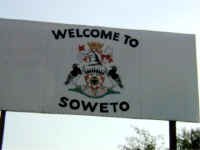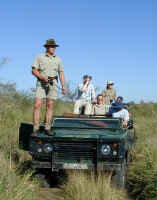South Africa Journal
May 16th
We arrived in Johannesburg this evening after our 22-hour flight. Even though we left on Tuesday morning, because of the difference in time zones we lost half of a day and didnít arrive until Wednesday night! The flight was uneventful, but boy was it long! The best part about it was that each seat had its own video monitor and controls to watch movies or TV, play games or listen to music. You could start and stop whenever you wanted to. That was great!
May 17th
In 1948 the Group Areas Act forced blacks into neighborhoods that were for blacks only and segregated them from the whites. All minorities were forced to live separately from the whites and from each other. Soweto (as it became known) became the area within Johannesburg where the blacks were forced to live. Laws called Pass Laws were enacted that only allowed the blacks to leave if they had special permission and passes. They had to be back in the township by 5:00 at night or they would be arrested.
For almost 30 years, the black residents of Soweto lived their lives according to the Apartheid laws. During those years there were attempts to create change and many people from Soweto, including Nelson Mandela, were arrested and sent to prison.
But the tide turned on June 16, 1976, when police fired on a group of Soweto school children marching to protest the teaching in schools of the Afrikaans language, (considered the language of their oppressors). Thus began the final struggle for freedom. From 1976 to 1994, when elections were finally held, Soweto was in a virtual state of war. Many thousands of blacks died and many more were arrested, tortured and held in prisons without trials.
Nationwide, strikes were called and demonstrations were held. Communities began to organize and politicize. World opinion turned against the white government and economic sanctions and boycotts were begun against the country.
By 1989 economic conditions were so severe that the white population began calling for change. FW De Clerk was voted in as president and immediately began to institute changes. By 1994, elections were held in which blacks could participate for the first time and the election was won by the African National Congress who named Nelson Mandela the first black president of South Africa.
A local resident named Neo (Zulu for Hope) led our visit to Soweto. He explained that the township has an upper class, a middle class and a lower class. Because there are 3 million people living in the township, there are opportunities for money to be made, so there are millionaires with their beautiful homes. Neo showed us the schools with their neatly uniformed students, the hospital (the largest in the world with 5,000 beds) and the middle-class neighborhoods where the government workers live in subsidized housing. We also visited a shantytown. The shantytown consisted of homes made from whatever materials could be salvaged (mostly tin and cardboard). There were spigots for water only on the outskirts of the town and the only sanitary facilities were portable toilets recently brought in by the government.
We also visited the home where Nelson Mandela lived during his law student days (which is now a museum) and the homes of Winnie Madikizela-Mandela and Desmond Tutu. The street that the homes of Mandela and Tutu are on has the distinction of being the only street in the world with two Nobel Peace Prize winnersí homes on it.
The community of Soweto reflects the resilience of the people who live there and even though the government no longer requires the blacks to live in Soweto, people stay because that is what they are familiar with and that is where their homes are. It is now like neighborhoods all over the world with all kinds of different people. Only it has the distinction of being the flashpoint of one of the biggest social upheavals in modern history.
May 18 -21
Kruger Park is in the northeast part of South Africa, near the Mozambique border. It is the premier park of the South African park system. Our safari camp was actually located in a private reserve right next to the park. The name of the reserve is Manyeleti, which in the local language means "The Place of the Stars". There are no fences between any of the reserves and the park, or even between the borders of South Africa, Zimbabwe and Mozambique. The animals are free to roam anywhere they want.
During the Apartheid years our reserve was actually for blacks only because it was illegal for them to visit Kruger Park. Anyone trying to use the others park could be arrested.
Back to the Safari. After seeing the lions we wondered if our experience could get any better. The answer was yes. On our game drives in our open air Land Rover, we continued to spot more and different types of animals. Giraffes, zebras, wildebeest, impalas and gnu were just some of the many animals we saw. There were also dozens of birds and insects. Click here to see the complete list of animals that weíve seen. This list will be added to throughout the expedition.
Then came the walking safaris. Our guide, Garth, told us it was very important for us to walk single file behind him as the animals would think that there was only one person and they would be less concerned about us watching them. Of course Garth carried his rifle just in case! We carried our Olympus digital camera and our Bushnell perma view binoculars.
One morning we drove around looking for just the right spot to go walking. Garth picked up the trail of an elephant, so we quickly parked the Land Rover and headed off into the bush. After a few minutes we could hear the sound of wood breaking, so we knew the elephants were close. The sound we could hear was the sound of the elephants ripping the branches off of trees so that they could eat the bark.
As we crouched and watched, three elephants came into view and we were treated to a small view of elephant culture. The elephants were all bulls (males). The biggest of the three stood ten feet tall at the shoulder and had two great big ivory tusks that were each at least six feet long. He was magnificent. The two younger bulls were actually protecting the older elephant from predators, like lions or humans.
As we moved around trying to get a better view, we scared up a herd of zebras. The two younger bulls moved around the see what had caused the zebras to flee. Then the older one spotted us. We stood very still. First he looked at us, and then he flared his ears, shook his head and spat into the air. We decided to move a little bit further away.
We stayed and watched for maybe an hour before returning to camp for lunch. It was fabulous to get so close to such a huge animal while we were on foot. Very exciting.
Our safari camp was located on the edge of a small creek that only months before had been a raging torrent of water after weeks of rain. The creek had literally washed the camp away, but it was quickly rebuilt so that people could visit the Reserve. The camp consisted of five large canvas tents for the guests, a cooking tent (our chef Elias was a great cook) and a beautiful viewing area. One afternoon we sat and watched a group of baboons playing in the trees nearby. And no, we didnít have to sleep on the ground as the tents came complete with cots and mattresses. Our hosts were Judy and Bruce from Trans Frontiers Safaris.
Our safari seemed to end too quickly. On our drive out of the Reserve, it was as if the animals all came to say goodbye. We saw more zebras, a giraffe, a cape buffalo, and another elephant. When we returned to the Trans Frontiers lodge, we said our goodbyes and began our drive to Pretoria.
Weíll be leaving in just a couple of days for Zimbabwe.

